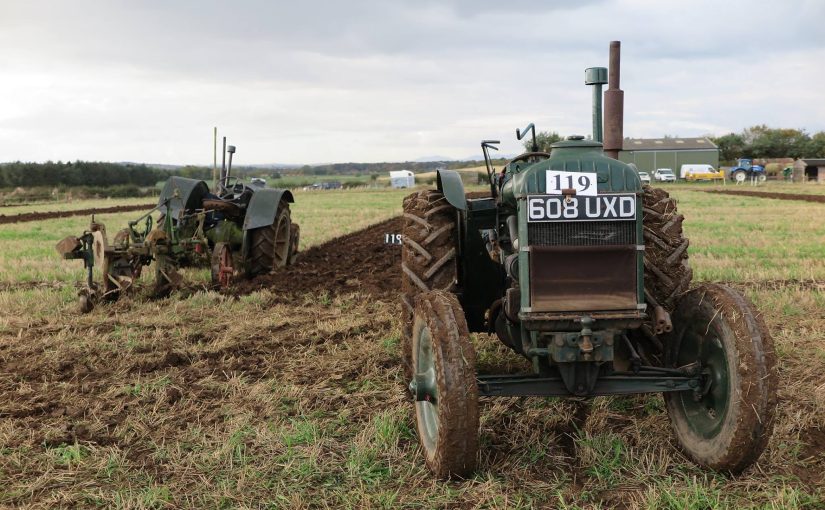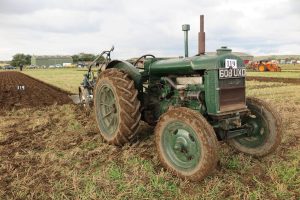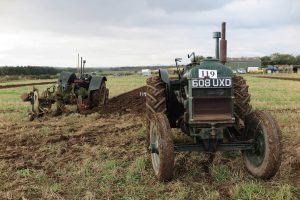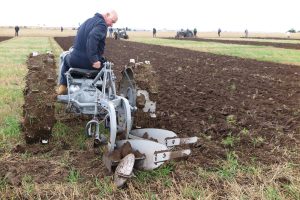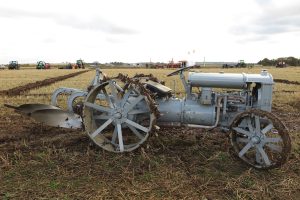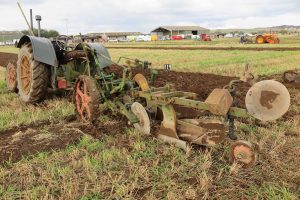The tractor trials of the Royal Highland and Agricultural Society of Scotland in October 1922
In October 1922 the Royal Highland and Agricultural Society of Scotland conducted trials of farm tractors and tractor implements at Fordel, Dalkeith. These were important, following on from earlier trials in 1917. These trials were widely reported in the newspaper press and in the Society’s own Transactions.
The following are two accounts of these important trials. The first is from the Aberdeen press and journal of 19 October 1922:
“Tractor trials
Satisfactory work at Dalkeith
(from our own correspondent)
Yesterday the Highland and Agricultural Society continued their demonstration at Fordel, Dalkeith of tractors and tractor implements. The numbers forward surpassed those at the opening proceedings.
Two Fordson tractors operated lots no. 1 and 9 respectively. To both were affixed two furrow Oliver no. 7 ploughs, specially constructed at the instigation of Mr Henry Ford to suit the Fordson tractor. The same shares were used on the previous day on the stubble break, and with disc coulters the work accomplished was deemed highly satisfactory. The furrows were ploughed to a depth of 6 ¾ ins by 10 in wide, clearly taken out, and the green well turned down. Three Case tractors were prominent. The new design. No. 3, with a three-furrow Ransome plough, did admirable work, the feature being the uniformity of the furrows and the compactness in turning. Lot no. 18 was operated on by their 10-18 bhp Modeae, in conjunction with a two-furrow Massey-Harris plough. Here the furrows were turned to a depth of 7 in by 10 in wide, compactly laid over, well taken out, and the work was recognised as being in the front rank. Their heavy tractor A, 15 to 27 bhp, was working a three-furrow Cockshut plough, and the work was fairly good.
Two 25 hp Glasgow tractors stood their tests remarkably. To one was attached a three-furrow Oliver plough with specially-designed Morton mould boards, lea socks, and disc coulters. Furrows 10 in wide by 7 in deep were beautifully turned and well taken out.
The New Morton two-furrow was one of the best in the field, and the work accomplished evinced entire satisfaction. The furrows, 10 inches by 7 inches deep, were turned with commendable precision. Three Hart-Parr tractors were in operation. To one was attached a three-furrow Martin, the work of which did not meet with approval. To counteract this, on lot no. 4 their design with a Sellar two-furrow no. 27 attached, the deficiency was more than made good. A self-lift Begg plough did good work. An Austin with a two-furrow Ransome plough turned a regular, well-set-up furrow. The plough known as R.S.L.D. and is fitted with the new R.N.D. mould board. The International Junior was represented on three lots, their best ploughing been done by a two furrow Sellar attachment.
The British Wallis, with a Ruston-Hornsby three-furrow plough, scarcely maintained its high reputation of the previous day. The furrows were 7 inches deep by 8 ½ inches wide, but were not too closely packed. Two Cletrac tractors, with two-furrow Ransome plough, did fairly satisfactory work, while a 20-hp Blackstone tractor, with three-furrow Howard attachment, was deemed unsatisfactory. Two Simar rotary tillers again operated on the stubble field. The heavy weight, a 28 cwt or 25 bhp machine, had a large following, while their lighter-weight, a 7 cwt design of 8 bhp. Is most suitable for market gardeners.”
The second account was published in The Scotsman of 3 February 1923. In essence it is a summary of the account published by the Highland Society in its Transactions:
“Farm tractors and implements
Midlothian demonstration
Highland Society’s report
The directors if the Highland and Agricultural Society issued yesterday a volume on the demonstration of farm tractors and tractor implements, which was held, under their auspices, at Fordel, Dalkeith, in October. It contains a description of the tractors and the implements by Professor R. Stanfield, consulting engineer, and reports by the Committee.
Tractors
The Committee, in their general observations, record their appreciation of the marked advance which has taken place in tractor construction since the Society’s last demonstration in 1917. They note with satisfaction that many of the suggestions embodied in the report on that demonstration have now been given effect to. This is probably nowhere more noticeable than in regard to weight, the limit of 40 cwt set by the Society being found to exclude very few of the tractors at present in use in this country.
With regard to horse-power, and considering the work which a tractor is required to do on the farm, the Committee are of opinion that a minimum of 25 bhp is desirable. In arriving at this decision, the Committee have in view the fact that the tractor must have sufficient power, not only to draw a three furrow plough under ordinary conditions, but also to pull a cultivator to a proper depth, and taking a width at least equal to the full over-all width of the tractor.
The Committee’s former recommendation regarding the use of spuds, rectangular in section and about 3 ins to 4 ins in width, and from 4 ins to 5 ins in length, is now very generally adopted. There is a marked improvement in the accessibility oof the working parts, and, in most cases, in their protection from the effects of exposure to weather and the entrance of grit.
There is no advance to record in the adoption of spring connections and release devices between the tractor and plough. The use of a wooden peg, which shears through under excessive strain, appears to be the most popular method of release.
The use of an adjustable hitch, fitted either to the tractor or the implements, is now widely adopted with advantage.
It was noticeable that the tractors demonstrated were provided with. A variety of speeds suitable for the different operations which they are called upon to perform.
Practically all the tractors were easily manipulated and turned at the headlands, a 24 feet headland being found sufficient. Some of them could be turned in considerably less. Those tractors having a driving wheel in the furrow are more easily steered, and appear to obtain a better grip.
All the tractors appeared capable of being used with any implement as a one-man outfit.
Ploughs
In regard to ploughs, a distinct advantage since the last trial has also to be noted. Much good work was performed. All ploughs are now fitted with a self-lift arrangement. Many of them are also provided with an efficient means of adjustment to different widths and depths. In view of the varying conditions of soil in Scotland and the variety of work to be undertaken, a plough that is not adjustable must be regarded as being unsuitable. There is still room for improvement in this respect, not only in providing means of adjustment, but in the ease and rapidity with which adjustment may be effected. In this connection it may be noted that a tractor plough, taking 2 or 3 furrows, requires more adjustment than a horse plough.
The ploughs were mostly fitted with revolving discs and skim coulters. It was noticeable, however, that not one of these was capable of effectively paring the turf from the edge of the furrow slice and laying it in the furrow bottom in such a way as not to interfere with the proper packing of the ploughing. In most cases the skimmed portion was merely folded over, and left in such a position that the furrows could not be compactly put together.
Sub soiling ploughs
The committee were impressed with the work done by the ploughs with subsoil attachments, and consider that this is a type of implement which farmers might adopt more extensively with advantage, especially where land has been continuously ploughed for a long period with plain bottomed ploughs.
This method of sub-soiling, where the subsoil is broken up but left in position, can have no disadvantage, and should be highly beneficial in improving the drainage and in mitigating the evil effects of excessive drought.
Grubbers and cultivators
The grubbers and cultivators were demonstrated on a field of unbroken stubble. It was originally intended to show them cultivating across the ploughed land, but this was abandoned in deference to the wishes of the framer, who thought it would be a mistake to cultivate a field so well ploughed at this season of the year.
The work done on the stubble field was creditable to the various implements. For deep work on unbroken or hard land the demonstration showed that a grubber is more suitable than a cultivator. The cultivators shown, however, should be extremely useful for medium or lighter soils.
In selecting a cultivator, it is desirable to see that there is ample clearance not only between the tines, but also between the frame and the surface of the cultivated land. It would be an advantage if grubbers and cultivators were of sufficient width to cover the track of the tractor.
As grubbers and cultivators are mostly required for spring cultivation, a demonstration in autumn does not provide a satisfactory test of their capabilities.
Harrows
The harrows also were demonstrated under unsuitable conditions, these being, of course, mainly implements for spring cultivation. The capabilities of the disc and spring tooth harrows are well known, and used with tractors they can perform much useful work. Various ingenious self-lift harrows were shown, and doubtless the self-cleaning devices embodied in these will prove to be serviceable when operating on dirty land. “
The full account can be read at: https://archive.rhass.org.uk/…/transactions-of…/604035
It is interesting, when reading these articles, to see how far tractors have developed in the last century.
